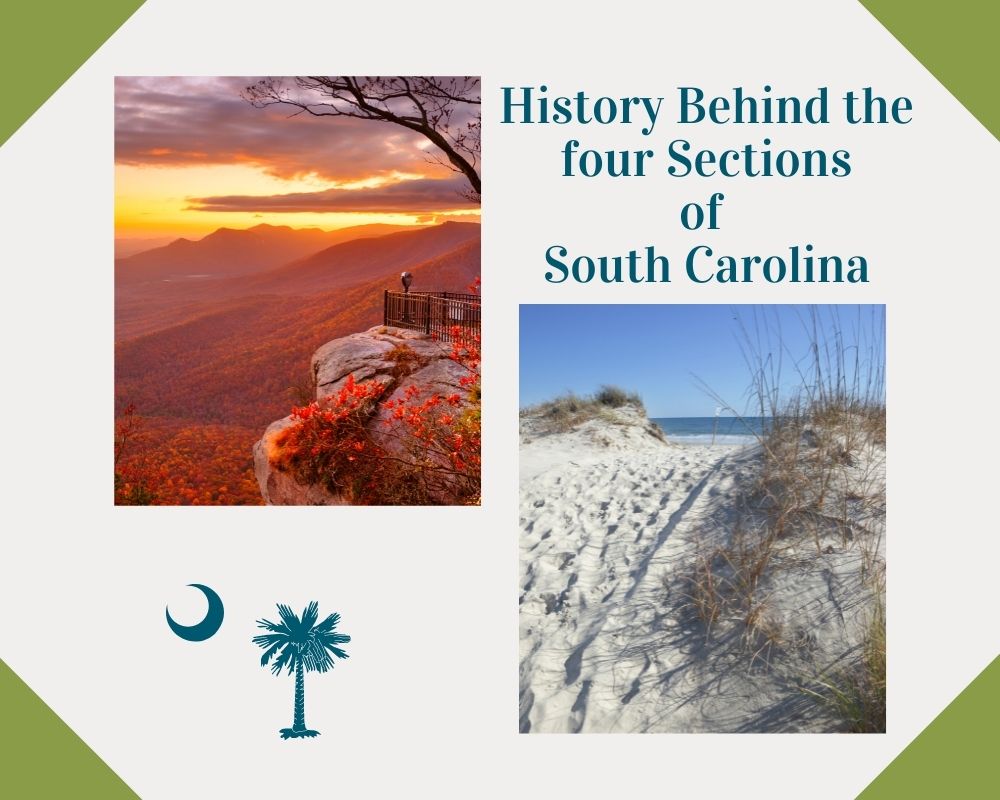History Behind the Four Sections of South Carolina
History Behind the Four Sections of South Carolina
Whenever you visit South Carolina, you will often hear those living in South Carolina talking about the state in sections or areas. These sections are known as Lowcountry, Pee Dee, Midlands, and Upstate — but why are they called these? In this blog post, we talk about the history of each, the background behind their names, as well as the main cities that you can find in each of these South Carolina sections.
Lowcountry
“Low Country” was a term that originally referred to all of the states below the Sandhills (the ancient sea coast) or the Fall Line which runs the width of South Carolina from Chesterfield County to Aiken County. As a result, the section that runs above Sandhills was coined as the Up Country, while the section below it was referred to as the Low Country. The areas included here not only have different geography and geology but also have varying cultures too.
History of the Lowcountry
In 1562, French explorer Jean Ribaut settled in Port Royal and established one of the area’s first colonies. By the late 1690s, the Sea Islands had become a permanent settlement and in 1711, the City of Beaufort became the second oldest city in the state. The city was named after the Duke of Beaufort, one of South Carolina’s Lord Proprietors.
However, between 1779 until 1781, the British Forces occupied the area around Beaufort. In the years that followed, there was an increase in agricultural production, allowing rice, cotton, and indigo to flourish in the area. As a result, Beaufort quickly became the most cultured and wealthiest town for its size, becoming famous for its sea island cotton.
Through the years, this section of South Carolina was heavily dependent on plantation agriculture but was also known for its architecture. Lowcountry-style architectural homes were developed in the late 1700s and are still being constructed today, as they have proven to be the most efficient design against the hot, subtropical climate present in this state. Historically, Lowcountry buildings have been made from timber and will either have a raised first floor or have been set on pilings. This is done to avoid the swampy environment, hurricane flooding, or high tide levels.
Broad hipped roofs were also a popular feature and extended over the large and deep-covered front porches that were accented by pillars or columns which made room for a shaded sitting area. Additionally, large windows were used to let warm air inside the house escape during the evening. Today, most modern homes in the Lowcountry will feature a central breezeway that allows air to flow throughout the whole house, helping to keep cool during hot summer days.
The City of Charleston
The largest city in South Carolina, Charleston is one of the more popular destinations for both tourists and locals alike. Located in Charleston County, it lies in the center of South Carolina’s coastline and has an estimated population of around 137,566 as of 2019. It was founded in 1670 as Charles Town in honor of King Charles II and was located at Albemarle Point by the west bank of the Ashley River, which is now known as Charles Towne Landing.
However, the site was relocated in 1680 to where it is presently located, and became the fifth-largest city in the country in just ten years. By 1793, Charleston adopted its current name along with its incorporation as a city. Today, Charleston is known for its history, beauty, livability, shopping, cuisine, and business-friendly nature.
Charleston has plenty to offer visitors, from Spanish moss-draped trees and centuries-old mansions to cobblestone walks and various places of interest. It also provides a peek into the past with horse-drawn carriages, gas lamp-lit streets every night, and antebellum architecture. However, it’s certainly not stuck in the past. Those who only meant to visit this beautiful city end up staying there for good, thanks to its innovative restaurants, beautiful art galleries, and world-class facilities.
Living in the Lowcountry
Starting in the 20th century, the Lowcountry economy invested in other sectors, with tourism being the most popular one in recent times. Much-loved attractions such as historic and cultural sites, seaside resorts, and natural features, such as state, local, and federally protected or preserved wetlands and lands are abundant here. Furthermore, the subtropical climates of this area allow for plenty of fun and enjoyable recreational activities.
The Lowcountry is a vacationer’s paradise and is the prime destination for tennis, golf, and beach vacations, with Hilton Head being the ultimate place for relaxation and adventure. An early example of their fine resorts was the Hilton Head Sea Pines Plantation in the 1950s. Along with other longstanding seaside communities, it remains popular in the area as a great Lowcountry destination for visitors and residents alike.
If you’re looking for other destinations in the Lowcountry area, you can certainly visit other cities located here, such as Bluffton, Beaufort, and Port Royal.
Pee Dee
Located in the northeastern corner of South Carolina, Pee Dee is a region with an interesting name and an even more interesting history. Nestled along the lower portion of the Pee Dee River, this region was named after the Native Pee Dee Tribe — with approximately 200 members, they are a state-recognized tribe.
History of the Pee Dee
The region was originally the homeland of the Pee Dee Native Americans, who previously lived in the area as a part of the South Appalachian Mississippian culture. They lived in the Pee Dee region between 1000 to 1400 years ago, but a majority of the tribe left for unknown reasons. However, those that remained reside in this area to this day, where the seat of the tribal government has been located in Marlboro County starting from 1976.
Living in the Pee Dee
The largest city in the region is Florence, which encompasses the Grand Strand — a long stretch of beaches that run from North Carolina’s state border all the way down to South Carolina’s Winyah Bay in Georgetown County. The city’s coast is dominated by tourism, where beaches, shopping, amusement parks, golf, and fishing are included in visitors’ itineraries. Because of its endless activities and beautiful landscapes, the area is a popular destination for retirees across the country.
Its mild weather, low cost of living, and golf courses with some of the best golf commmunities in South Carolina have also contributed to the rise in population in recent years. Traveling inland provides visitors with marshes, rivers, sandy rises, and Carolina bays where there are forests everywhere. You’ll also find bald cypress trees, pine plantations, cotton, tobacco, soybeans, and various produce by making your way further inland.
Other major cities to visit in the Pee Dee include Myrtle Beach, North Myrtle Beach, and Conway.
Midlands
The Midlands is appropriately named since it consists of the middle part of the state, where the state’s capital, Columbia, is located — which also serves as the region’s main center. It may sound obvious, but this region is named as such because it is the halfway point between the Lowcountry and the Upstate.
This region largely coexists with the Columbia metropolitan area, including Orangeburg and Newberry counties but excluding Sumter County. Moreover, the central part of Orangeburg County is considered to be located in the Midlands, but the western part is considered to be under the Central Savannah River Area, while the eastern portion is part of the Lowcountry.
Living in the Midlands
In recent years, Midlands has become a huge business center in South Carolina, primarily because of its growing textile, paper, steel, and medical supplies production. Furthermore, it is a center for both medical use and farming, while also involved in tourism and attractions, providing venues for fishing, shopping, and entertainment.
If you’re looking for other great cities in the Midlands, be sure to visit Sumter, Lexington, and Orangeburg.
Upstate
The Upstate is located in the westernmost part of the state and is also referred to as the Upcountry, its historical term. Sitting between Charlotte and Atlanta, the Upstate sits in the middle of the Charlanta mega-region. Since BMW has made investments around the area, various other foreign companies have settled in the Upstate, where several corporations have established their headquarters.
As a result, major commerce and business take place in the Upstate, with Greenville County serving as the center of various transactions. Because of this, the Greenville-Spartanburg-Anderson MSA is known to be in the top seven markets for economic development in the whole country. Moreover, plenty of financial institutions also have regional offices located in Greenville, including the Bank of America.
Living in the Upstate
In this region, you can find cottage-style homes and historic bungalows which are within walking distance to parks, restaurants, and playgrounds. However, venturing into The Cliffs will give you a glimpse of stunning homes and provide you with six communities to choose from. However, young professionals who prefer to be close to the action can always opt for a loft-style apartment right at the heart of downtown.
Greenville is a city synonymous with the term “Upstate,” and ranks among the best places to live in this region. This city not only offers charm and convenience, but it also offers affordable housing options for those who are just getting started. It’s also a lively city, with more live events, festivals, and various other celebrations than you can remember. If you’re a foodie, a coffee lover, or just enjoy going around restaurants, you’ll also be happy to know that Greenville County alone has more than 1,000 restaurants.
If you wish to see other cities that the Upstate has to offer, be sure to check out Spartanburg, Anderson, Pickens, and Oconee.
No matter which region you’re heading to, South Carolina offers various geography, culture, economy, architecture, and delicious cuisine! The slow and relaxed Southern pace of life in each region provides both visitors and residents with a unique experience that you won’t find anywhere else. Because of this, living here has become appealing for many people, and has become a wildly popular destination for tourists all over the world. For outsiders, South Carolina presents visions of palmetto trees, shrimp boats, wide front porches with rocking chairs, and jugs of delectable sweet tea — everything that makes South Carolina a traveler’s dream.






